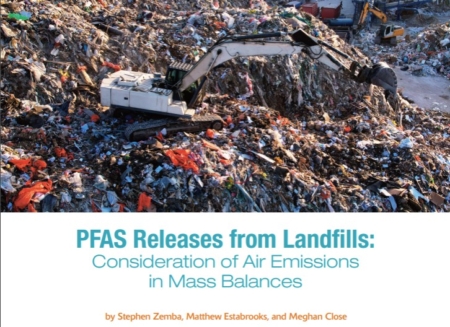Our last blog on PFAS air issues promised a follow-up, but we are deferring that discussion in lieu of some observations on the values proposed by EPA as health protective levels of PFAS in surface water and biosolids, as there is opportunity to provide comment.
EPA recently proposed ambient water quality criteria at part-per-quadrillion levels and released a biosolids risk assessment that indicates human health risks at a 1 ppb level (consistent with background in soils in VT and other states). These proposals follow the evolution of PFAS toxicity data to increasingly protective values.
In mid-2022, EPA issued interim Drinking Water Health Advisories (HAs) for Perfluorooctanoic acid (PFOA) and Perfluorooctane sulfonic acid (PFOS) at levels of 0.004 and 0.02 parts-per-trillion, respectively. These values raised some initial attention, but they were overshadowed by the promulgation of enforceable Maximum Contaminant Levels (MCLs) at concentrations of 4 ppt. The PFOA and PFOS MCLs, however, are not based on health risks, but rather on practical quantitation limits since the MCL goal was set at zero due to suspected carcinogenicity. The lower interim HAs (which remain in place) represent EPA’s risk-based values for drinking water.
| Year | Health Advisory (HA) | Maximum Contaminant Level (MCL) | Maximum Contaminant Level Goal (MCLG) | |||
| PFOA | PFOS | PFOA | PFOS | PFOA | PFOS | |
| 2009 | 400 | 200 | – | – | – | – |
| 2016 | 70 | – | – | – | – | |
| 2023 | 0.004 | 0.02 | – | – | – | – |
| 2024 | – | – | 4 | 4 | 0 | 0 |
Values in nanograms/liter (ng/L) = parts-per-trillion (ppt)
This past December, however, EPA re-emphasized its focus on sub-ppt concentrations of PFOA and PFOS with its proposed recommendations for national ambient water quality criteria (AWQC) for the protection of human health, which it issues per the mandate of the Clean Water Act.
| Exposure Pathways | PFOA | PFOS |
| Fish Ingestion Only | 0.0036 | 0.07 |
| Fish Ingestion and Drinking Water Consumption | 0.0009 | 0.06 |
The proposed 0.0009 ppt value for PFOA is less than a part-per-quadrillion (ppq), presenting a new challenge for those of us who attempt to communicate intuitive understandings of very small concentrations (see our ppq challenge at the end of this blog). EPA is proposing PFOA and PFOS AWQCs at levels that are considerably lower than can be quantified by EPA’s analytical methods. Detecting PFOA or PFOS in surface water will signal an exceedance of the proposed AWQCs, and data indicate this may happen frequently for PFOA, given several studies showing it to be commonly measurable at ppt levels in surface water, i.e., at concentrations 2-3 orders of magnitude higher than EPA’s proposed criteria. For example, a 2019 surface water survey in Pennsylvania detected PFOA above the study reporting limit (0.8 ppt) in 69% of the samples. As another example, a 2019 surface water study in New Jersey detected PFOA at all sampling locations, with concentrations ranging from 1.1 to 14.6 ppt. PFOS was also detected at 9 of the 11 sampling locations at concentrations ranging from 2.8 to 100 ppt. EPA has recently extended its comment period and is now accepting comments on its proposed AWQCs until April 25, 2025.
EPA also extended the public comment period on its draft biosolids risk assessment until April 16, 2025. As stated by EPA in its fact sheet, “EPA finds that there may be human health risks exceeding the EPA’s acceptable thresholds for some modeled scenarios when land-applying sewage sludge that contains 1 part per billion (ppb) of PFOA or PFOS.” Given that most biosolids contain more than 1 ppb of PFOA and PFOS, land application of biosolids (a widely practiced and recommended beneficial reuse) may be under reconsideration.
Comments submitted on the proposed surface water standards and biosolids risk assessment may have more meaningful impact given the change in administration at EPA. At the base of EPA’s ever-lowering PFAS standards and guidelines – and also one of the greatest sources of uncertainty – are EPA’s published toxicity data, which continue to be revised to more conservative values. A search of EPA’s Regional Screening Level (RSL) database shows PFOA to have the second highest cancer potency of all chemicals – second only to dioxin.
| Cancer Potency (mg/kg-day)-1 | Chemical |
| 130,000 | 2,3,7,8-TCDD |
| 29,300 | PFOA |
| 13,000 | PCB 126 (Pentachlorobiphenyl, 3,3′,4,4′,5-) |
| 6,200 | Hexachlorodibenzo-p-dioxin (mixture) |
| 3,900 | PCB 169 (Hexachlorobiphenyl, 3,3′,4,4′,5,5′-) |
| 550 | 1,2-Dimethylhydrazine |
| 350 | Diethylstilbestrol |
| 250 | 7,12-Dimethylbenz[a]anthracene |
| 240 | Chlorozotocin |
| 230 | Benzidine |
Similarly, an RSL database search indicates that Perfluorodecanoic acid (PFDA) has the second lowest reference dose (again, second only to dioxin). Note that reference doses represent “safe” levels of exposure to a chemical, and non-cancer hazard quotients are estimated by dividing exposure by them. Hence lower reference doses imply greater potential toxicity. PFOA and PFOS rank 5th and 8th on the list, which we expanded to 14 chemicals to include additional PFAS such as GenX.
| Reference Dose (ng/kg-day) | Chemical |
| 0.0007 | 2,3-7,8-TCDD |
| 0.002 | PFDA |
| 0.007 | PCB 126 (Pentachlorobiphenyl, 3,3′,4,4′,5-) |
| 0.02 | PCB 169 (Hexachlorobiphenyl, 3,3′,4,4′,5,5′-) |
| 0.03 | PFOA |
| 0.06 | δ-Hexachlorocyclohexane |
| 0.1 | Tetraethyl Lead |
| 0.1 | PFOS |
| 0.8 | Lindane |
| 2.33 | PCB 81 (Tetrachlorobiphenyl, 3,4,4′,5-) |
| 3 | GenX (HFPO-DA) |
| 3 | PFNA |
| 3 | Perfluoro(2-propoxypropanoate) |
| 3 | Ammonium perfluoro-2-methyl-3-oxahexanoate |
Using these current values in risk assessments will likely result in PFAS becoming “risk drivers” in risk assessments at sites where PFAS are included in remedial investigations. EPA’s toxicity values also have interesting implications with respect to background exposures and public health risks. Some ballpark risk estimates can be generated from estimates of historic exposure to PFOA and PFOS. Based on pharmacokinetic modeling reconstructions, peak exposure to PFOA in the U.S. occurred from 1995 to 2000 at an adult exposure level of 1.1 ng/kg-d. The incremental cancer risk estimate CR is:
CR = (1.1 ng/kg-d) × (5 yrs / 70 yrs) × (29,300 kg-d/ng) = 0.0023 = 0.23% = 2,300 per million
The 2,300 per million estimate is 23 times the upper-end of the Superfund program’s target range (100 per million), but 10 times lower than the current actuarial risk of kidney cancer in the U.S. of 2.3%. For non-cancer health effects, the hazard ratio HR is estimated as:
HR = (1.1 ng/kg-d) ÷ (0.03 ng/kg-d) = 37
This value exceeds the target value of 1 that corresponds to no appreciable chance of adverse health effects. A similar HR calculation can be developed for PFOS, for which historic exposure of 4.5 ng/kg-d has been estimated over a 10-year period from 1988 to 1998:
HR = (4.5 ng/kg-d) ÷ (0.1 ng/kg-d) = 45
which also exceeds the target de minimis risk value of 1.
The example risk estimates do not necessarily mean that health effects have occurred, as they are based on extrapolations of data collected in laboratory animal toxicity studies. Critics of EPA’s toxicity data point out that the rat is not a good surrogate for humans, casting large uncertainties on these estimates.
Part-per-Quadrillion (ppq) Challenge
What analogy would you suggest to communicate a ppq?
Google’s AI Overview provided the following ppq analogies:
- A postage stamp on a letter as large as California and Oregon;
- A human hair compared to all the hair in the world;
- One mile in a journey of 170 light years;
- Traveling 0.15 millimeters on a trip to the Sun;
- The area of one footprint in North America.
We have not verified any of the above analogies, but even if accurate, they are still difficult to fathom. Perhaps readers can send us better suggestions? Submit your suggestions via email to Marketing@sanbornhead.com. We’ll send some Sanborn Head swag to the reader who sends us best analogy (per our judgement) and announce the winner in our next blog.





